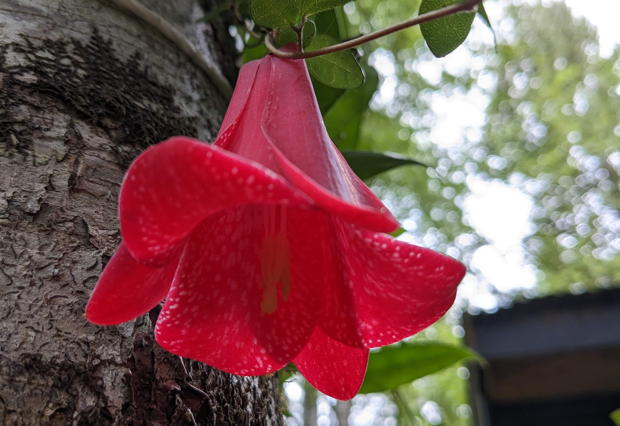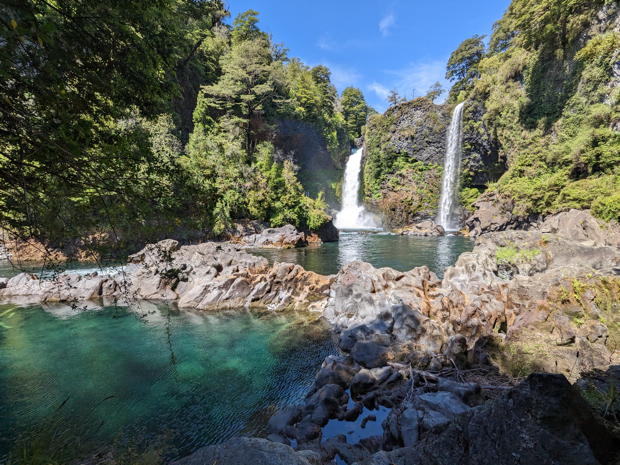
The copihue, Chile's national flower
Huemuls are disappearing in Patagonia. With their large, swiveling ears and gentle ways, this southernmost deer species is a beloved icon of the region’s resilience and beauty. According to recent estimates, there are less than 1500 individual huemuls alive in the wild. They are on the IUCN’s red list for endangered species.
During my family’s sabbatical in South America, we have visited several huemul habitats. Standing in the protected places where these lovely animals roam, it hits home how precarious their existence is. A few thousand more acres of deforestation, or a few more years of extreme heat that devastates the plants they feed on, and there could be no more huemuls wandering the planet.
I feel a rock of grief in my belly at this thought. But another, more practical voice — the devil’s advocate, I suppose — speaks up. So what? Species have gone extinct in the past. Does huemul extinction really matter in the grand scheme of things? And it doesn’t affect you personally, so, why get sad?
We have become more aware of the importance of cultural diversity in recent decades. Academically-minded Christians, especially, are part of regular conversations in our organizations and communities about how to truly include and empower people of all races and backgrounds. In fact, as a board member of A Rocha USA, a Christian biodiversity conservation nonprofit, I recently facilitated a process of integrating cultural diversity priorities into our organization.
There are clear parallels between cultural diversity and biodiversity. We value all the different kinds of life — from humans to plants to fungi–because God created each one. But often, organizations prioritize one kind of diversity over the other. The reality is that cultural diversity and biodiversity are intertwined.
Biodiversity feeds cultural diversity.
There is a glorious, often-referenced image in Revelation about God’s coming kingdom, one where “all nations and tribes, all races and languages” (Revelation 7:9, MSG) worship at the throne of the Lamb. I picture this as a vast, colorful crowd of humans beating drums, swishing scarves, and shaking rattles. But where do these accoutrements come from? How did our unique languages — with which we worship God — emerge?
As indigenous societies around the world recognize, we are formed by the land. Our identities, favorite foods, and even our words, arise from the varied shapes and textures of precipitation, wind, flora, and fauna around us. Our drums are carved from the wood of maple, birch, wenge, and jatoba trees, among many others. Our scarves are knit with threads, perhaps from silkworms, sheep, or cotton. Our marimbas, maracas, and rakataks are made with gourds growing from our corner of the earth. So much of the riotous creativity that is human culture, from music to poetry to culinary delights, draws from the raw materials offered by nature. Nature and culture cannot be disentangled.
Here in southern Chile, where my family has spent the past month, we have enjoyed tart maqui and calafate berries that dye our lips purple. We’ve admired the drooping bright-pink copihue that is Chile’s national flower. We’ve savored the succulent seafood that inspired the poetry of Pablo Neruda, including a 73-line poem called “Oda al Caldillo de Congrio” (Ode to the Conger Eel Stew). While some of the elements that inspire Chilean culture are stable, others are under threat because of habitat loss, overuse, and climate change. What will Chile be without the huemul, the copihue flower, or conger eel stew?

Huilo-Huilo Nature Reserve, a piece of privately owned land being protected for conservation, where huemuls are being reintroduced.
A recent UN report estimates that over one million species are currently threatened with extinction, and the rate of extinctions is increasing. We’ve already lost at least 20% of the average abundance of native species on major land-based habitats since 1900. Humans will certainly keep living and being creative with what’s left, but we will be functioning at diminished capacity.
Why? Because our well-being is intertwined with the well-being of the rest of creation. Biodiversity feeds cultural diversity. It also contributes to our ability to withstand the coming climate changes. Already, agronomists are exploring the genetic makeup of wild relatives of cultivated crops to select for resistance to drought, extreme heat and cold, and other weather onslaughts. Biodiversity hotspots hold the keys to our ability to survive a warming world of wilder weather. Just as diverse human groups make smarter, more successful decisions, so diverse ecosystems have more resources at their disposal to adapt to an unpredictable future.
Each Creature’s Worth
At the recent UN Biodiversity Conference (COP15) in Montreal, parties resolved to protect 30% of earth’s surface for conservation by 2030. This was one of the several landmark goals set, which framed the importance of saving species from extinction because they are key to human flourishing.
My international colleagues from A Rocha showed up too. Outside of underscoring the importance of conserving other species for human survival, I appreciate that they presented a Christian view of why extinction matters to God (see p. 12-13). In short, each species stands on its own intrinsic value as a creature that God made, loves, and sustains. Each has something unique to show us about God’s self-revelation (Romans 1:20). Each has a place in the renewed creation that God has initiated through Christ, and which he invites each of us to participate in.
Back to the images in Revelation, some of my favorites come in the last chapters, where the city of God descends to earth. “God moved into the neighborhood, making his home with men and women” (Rev. 21:3, MSG). Might I also add, God moved in with the monarchs and pumas and kelp?
In the last chapter of Revelation, we have an image of a river of life flowing from the throne of God and a tree planted on each side of the river, producing fruit and bearing leaves for the healing of the nations (22:1-2). Here, we see that it’s not just humans who glorify God. Trees, river, fruit, and leaves are also part of the picture. And these are only the elements of nature that are visible to the author.
We know that trees communicate with each other through underground mycorrhizal fungal networks. They bear fruit with help from birds, ladybugs, bees, and other pollinators. Insects, in turn, rely on other unseen partners – microorganisms in the soil, in their guts, and in their gardens. Water, too, doesn’t stand alone. It is filtered by rocks and sediment, which are formed by geological processes deep within the earth. Every noticeable part of creation is part of a larger, oft-unseen “community of creation” (to quote the indigenous theologian Randy Woodley). No one element exists without the whole.
It’s unclear how these natural processes, from tree communication to water filtration, will continue in the renewed heavens and earth. But we have a God who loves using material elements, who still eats fish in his resurrected form (Luke 24:42-43), who provided wine for a wedding banquet using water and earthen jars (John 2), who gave sight to blind eyes using mud and saliva (John 9:6-7). Thus, I suspect that in the renewed creation these natural processes will somehow continue to be part of God’s way in the world.
That means, by extension, that huemuls matter to God. They, too, glorify God and are wrapped up in God’s desire to restore all things. Without the huemul, something is missing.
As we continue to discuss the importance of diversity, let’s not forget the vastness of our communities, which include humans as well as other-than-human creation. Let’s prioritize biodiversity as well as cultural diversity. We want everyone and everything that God has made at the throne worshiping the Lamb in God’s renewed heaven and earth.
Photos by Liuan Huska